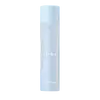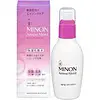What's inside
What's inside
 Key Ingredients
Key Ingredients

 Benefits
Benefits

 Concerns
Concerns

No concerns
 Ingredients Side-by-side
Ingredients Side-by-side

Water
Skin ConditioningCocos Nucifera Water
MaskingButylene Glycol
HumectantGlycerin
HumectantGlyceryl Sesquioleate
Emollient1,2-Hexanediol
Skin ConditioningIsopentyldiol
HumectantSodium Citrate
BufferingSaccharide Isomerate
HumectantEthylhexylglycerin
Skin ConditioningPhlox Drummondii Seed Extract
Skin ConditioningCitric Acid
BufferingSodium Phytate
Sodium Polyacrylate
AbsorbentSodium Hyaluronate
HumectantGlyceryl Glucoside
HumectantGlycine
BufferingGlutamic Acid
HumectantArginine
MaskingLysine
Skin ConditioningMethionine
Skin ConditioningValine
MaskingSerine
MaskingAspartic Acid
MaskingIsoleucine
Skin ConditioningAlanine
MaskingOrnithine
Skin ConditioningTaurine
BufferingPhenylalanine
MaskingProline
Skin ConditioningHistidine
HumectantArtemia Extract
Skin ConditioningHydrogenated Lecithin
EmulsifyingSodium Hyaluronate Crosspolymer
HumectantPotassium Hyaluronate
Skin ConditioningHydroxypropyltrimonium Hyaluronate
Hydrolyzed Sodium Hyaluronate
Skin ConditioningHydrolyzed Hyaluronic Acid
HumectantHyaluronic Acid
HumectantLactobacillus Ferment
Skin ConditioningMadecassic Acid
Skin ConditioningAsiaticoside
AntioxidantAsiatic Acid
Skin ConditioningCaprylic/Capric Triglyceride
MaskingPentylene Glycol
Skin ConditioningSodium Acetylated Hyaluronate
HumectantWater, Cocos Nucifera Water, Butylene Glycol, Glycerin, Glyceryl Sesquioleate, 1,2-Hexanediol, Isopentyldiol, Sodium Citrate, Saccharide Isomerate, Ethylhexylglycerin, Phlox Drummondii Seed Extract, Citric Acid, Sodium Phytate, Sodium Polyacrylate, Sodium Hyaluronate, Glyceryl Glucoside, Glycine, Glutamic Acid, Arginine, Lysine, Methionine, Valine, Serine, Aspartic Acid, Isoleucine, Alanine, Ornithine, Taurine, Phenylalanine, Proline, Histidine, Artemia Extract, Hydrogenated Lecithin, Sodium Hyaluronate Crosspolymer, Potassium Hyaluronate, Hydroxypropyltrimonium Hyaluronate, Hydrolyzed Sodium Hyaluronate, Hydrolyzed Hyaluronic Acid, Hyaluronic Acid, Lactobacillus Ferment, Madecassic Acid, Asiaticoside, Asiatic Acid, Caprylic/Capric Triglyceride, Pentylene Glycol, Sodium Acetylated Hyaluronate
Water
Skin ConditioningButylene Glycol
HumectantPentylene Glycol
Skin ConditioningDipropylene Glycol
HumectantErythritol
HumectantPEG-60 Hydrogenated Castor Oil
EmulsifyingXanthan Gum
EmulsifyingPPG-6-Decyltetradeceth-30
EmulsifyingPEG-32
HumectantDipotassium Glycyrrhizate
HumectantSodium Citrate
BufferingSodium Hyaluronate
HumectantGlycerin
HumectantAcetyl Hexapeptide-38
Skin ConditioningValine
MaskingThreonine
Serine
MaskingLeucine
Skin ConditioningProline
Skin ConditioningHistidine
HumectantGlycine
BufferingAlanine
MaskingArginine
MaskingLysine Hcl
Skin ConditioningCarnosine
Skin ConditioningPhytosteryl/Octyldodecyl Lauroyl Glutamate
Skin ConditioningPolyquaternium-61
Skin ConditioningPhenoxyethanol
PreservativeHydrogenated Lard
EmollientPolyglyceryl-10 Laurate
Skin ConditioningWater, Butylene Glycol, Pentylene Glycol, Dipropylene Glycol, Erythritol, PEG-60 Hydrogenated Castor Oil, Xanthan Gum, PPG-6-Decyltetradeceth-30, PEG-32, Dipotassium Glycyrrhizate, Sodium Citrate, Sodium Hyaluronate, Glycerin, Acetyl Hexapeptide-38, Valine, Threonine, Serine, Leucine, Proline, Histidine, Glycine, Alanine, Arginine, Lysine Hcl, Carnosine, Phytosteryl/Octyldodecyl Lauroyl Glutamate, Polyquaternium-61, Phenoxyethanol, Hydrogenated Lard, Polyglyceryl-10 Laurate
Ingredients Explained
These ingredients are found in both products.
Ingredients higher up in an ingredient list are typically present in a larger amount.
Alanine is an amino acid and is already found in the human body. Our skin uses alanine to build collagen, elastin, and keratin.
Arginine is an amino acid that is important for human development. Your body uses is it to produce hair keratin and skin collagen.
As a cosmetic ingredient, Arginine has antioxidant properties and can also help repair damaged skin. This ingredient is derived either synthetically or from animals.
Arginine isn't fungal acne safe when used in the presence of other lipids (fats, fatty acids, oils, esters, etc). Oils and fats occur naturally within the skin, so take caution when using Arginine if you're prone to fungal acne.
Learn more about ArginineButylene Glycol (or BG) is used within cosmetic products for a few different reasons:
Overall, Butylene Glycol is a safe and well-rounded ingredient that works well with other ingredients.
Though this ingredient works well with most skin types, some people with sensitive skin may experience a reaction such as allergic rashes, closed comedones, or itchiness.
Learn more about Butylene GlycolGlycerin is already naturally found in your skin. It helps moisturize and protect your skin.
A study from 2016 found glycerin to be more effective as a humectant than AHAs and hyaluronic acid.
As a humectant, it helps the skin stay hydrated by pulling moisture to your skin. The low molecular weight of glycerin allows it to pull moisture into the deeper layers of your skin.
Hydrated skin improves your skin barrier; Your skin barrier helps protect against irritants and bacteria.
Glycerin has also been found to have antimicrobial and antiviral properties. Due to these properties, glycerin is often used in wound and burn treatments.
In cosmetics, glycerin is usually derived from plants such as soybean or palm. However, it can also be sourced from animals, such as tallow or animal fat.
This ingredient is organic, colorless, odorless, and non-toxic.
Glycerin is the name for this ingredient in American English. British English uses Glycerol/Glycerine.
Learn more about GlycerinThis ingredient is an amino acid that helps build proteins and moisturizes skin. It is already present in our skin as our bodies produce them naturally.
Glycine already plays a role in helping keep our skin moisturized as amino acids transport moisture throughout our skin.
As collagen is made up of glycine and other amino acids, it is believed glycine may help our skin produce more collagen.
Learn more about GlycineHistidine is a semi-essential amino acid used by our bodies to create protein. It has humectant and skin conditioning properties.
Our bodies use histidine to create filaggrin - filaggrin is a structural protein that the skin uses in maintaining skin barrier.
One study found histidine and carnosine to be a dynamic duo for your skin:
Oral histidine has also been found to help with filaggrin-deficit skin disorders such as atopic dermatitis.
Why is it considered a semi-essential amino acid? This is because adults are able to create it but children must get it from their diet.
Learn more about HistidinePentylene glycol is typically used within a product to thicken it. It also adds a smooth, soft, and moisturizing feel to the product. It is naturally found in plants such as sugar beets.
The hydrophilic trait of Pentylene Glycol makes it a humectant. As a humectant, Pentylene Glycol helps draw moisture from the air to your skin. This can help keep your skin hydrated.
This property also makes Pentylene Glycol a great texture enhancer. It can also help thicken or stabilize a product.
Pentylene Glycol also acts as a mild preservative and helps to keep a product microbe-free.
Some people may experience mild eye and skin irritation from Pentylene Glycol. We always recommend speaking with a professional about using this ingredient in your routine.
Pentylene Glycol has a low molecular weight and is part of the 1,2-glycol family.
Learn more about Pentylene GlycolProline is an amino-acid. It helps moisturize the skin and plays an important role in creating proteins.
Our skin uses proline as one of the building blocks for producing collagen.
In medicine, proline is used as an osmoprotectant. This means it helps prevent oxidative degradation in other drugs.
Our bodies are able to produce proline naturally, but certain conditions may inhibit this production. In that case, proline can be obtained from eating egg whites, soy protein, dairy products, asparagus, mushrooms, and seaweed.
Learn more about ProlineSerine is an amino acid naturally found in our body. Our bodies use amino acids to create protein.
Amino-acids help give keep our skin hydrated. They play an important role in the skin barrier, which keeps the skin plump and firm.
Serine is a non-essential amino acid, meaning we don't need to obtain it from eating foods.
Learn more about SerineSodium Citrate is the sodium salts of citric acid. In skincare, it is used to alter pH levels and acts as a preservative.
Its main functions are to maintain the pH of a product and neutralize metal ions.
The acidity of our skin is maintained by our glands and skin biome; normal pH level of skin is slightly acidic (~4.75-5.5).
Being slightly acidic allows our skin to create an "acid mantle". This acid mantle is a thin barrier that protects our skin from bacteria and contaminants.
Learn more about Sodium CitrateSodium Hyaluronate is hyaluronic acid's salt form. It is commonly derived from the sodium salt of hyaluronic acid.
Like hyaluronic acid, it is great at holding water and acts as a humectant. This makes it a great skin hydrating ingredient.
Sodium Hyaluronate is naturally occurring in our bodies and is mostly found in eye fluid and joints.
These are some other common types of Hyaluronic Acid:
Learn more about Sodium HyaluronateValine is an essential amino acid. It is used by our bodies for tissue repair and muscle growth.
An essential amino acid is one in which our bodies cannot naturally produce so we must get them through diet. Foods such as eggs, dairy, red meat, and fish contain valine.
This ingredient can either be derived from an animal product or be synthetically created.
Learn more about ValineWater. It's the most common cosmetic ingredient of all. You'll usually see it at the top of ingredient lists, meaning that it makes up the largest part of the product.
So why is it so popular? Water most often acts as a solvent - this means that it helps dissolve other ingredients into the formulation.
You'll also recognize water as that liquid we all need to stay alive. If you see this, drink a glass of water. Stay hydrated!
Learn more about Water